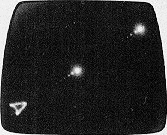PROGRAMMERS' NOTES:
How to
Win at Asteroids
| Despite the fact that most Atari programmers and engineers
are extremely conservative players, they can be handy people for an Asteroids player to
know. Following is a list of hints, tips, and company secrets that ought to improve your
game. 1. If you want to sound as if you know what you're doing when you play Asteroids, you can throw around some of the in-house slang that has grown up around the game. At Atari, the little flying saucer is called Mr. Bill; his big brother is Sluggo. Mr. Bill and Sluggo are also known as drones, which is a company word for the "computer-controlled intelligences" in video games. Turns or plays are known as lives. Each new series of asteroids is called a wall or wave. Individual asteroids are referred to as rocks. 2. Sluggo fires at random; Mr. Bill aims. "Mr. Bill knows where you are, and he knows what direction you're moving in, " explains programmer Ed Logg. "He takes this information and picks a window bounded a few degrees on each side of you, and then shoots randomly inside of that. For this reason, you should never move straight at him. It makes you bigger relative to him. The farther away you are, the smaller a target you are. " 3. The higher your score is, the more accurate Mr. Bill becomes. When your score reaches 35,000, he narrows down his firing window and increases his chances of hitting you. 4. Although Mr. Bill aims at you, he doesn't fly at you—at least not on purpose. His movements, like Sluggo's, are randomly determined within well-defined limits. His horizontal speed is always the same, which means he moves faster when he changes his angle of movement—something he does every second or so. 5. The first wall in an Asteroids game consists of four rocks, the second of six, the third of eight, and all succeeding walls often. (In Asteroids Deluxe the sequence is six, seven, eight, nine.) 6. The position, direction, and speed of the rocks at the beginning of a wall are random within a certain range. Contrary to what many players believe, the rocks do not speed up as the game progresses. |
7. Every large rock contains two medium-sized rocks,
each of which contains two small rocks. Smaller rocks are positioned at random within
larger ones. When a moving rock breaks up, the smaller rocks that constitute it will tend
to move in the same direction the larger rock was moving in ("There is conservation
of momentum," Ed Logg says), although pieces will occasionally break off in the
opposite direction. It is safer to fire at rocks that are moving away from your spaceship. 8. Your spaceship can fire up to four shells at a time. Once those shells have been fired, you can't shoot again until one of them either hits something or dies of old age. The lifetime of a shell is somewhat shorter than the time it would take it to travel all the way across the screen. 9. Because your ship's gun reloads every time one of your bullets hits something, you can sometimes fire in long, satisfying streams if you aim carefully at compact clusters of rocks. 10. If you are moving forward when you fire, your shells travel faster than they do if you are standing still. If you are moving backward, they travel more slowly. 11. Ed Logg's space, like Albert Einstein's, is curved: any object that disap-
A SPACESHIP |
pears off one side of the screen reappears at the
corresponding point on the opposite side. It is thus possible (and often desirable) to
destroy objects by firing away from them. (This fact, sadly, is one of the keys to the
odious lurking strategy.) In the original Asteroids, Mr. Bill does not take advantage of
this wrap around effect, aiming only "into the screen" even when he would have a
better chance of hitting you by firing off the side. 12. No rock moves straight up and down or straight across the screen. If the rocks were allowed to do that, it would be possible to have on the screen a rock that you wouldn't be able to see. As is also true of your television set, the picture on an Asteroids monitor is usually somewhat larger than the screen. This means there is sometimes a fairly wide margin of invisible space around the edges of the visible image. If the rocks could travel parallel to either of the axes, you could have one in the invisible margin and never find it unless you hit it by accident. 13. When you push the Hyper Space button, you have approximately one chance in five of blowing up on reentry, even if you rematerialize in an empty section of the screen. Players who rely heavily on Hyper Space are taking their lives into their hands. The best players use the button only in dire emergencies. 14. If your favorite Asteroids machine one day seems faster than usual, the operator may have installed a modification kit to speed it up. These kits increase the speed of all moving objects on the screen (including your spaceship and its bullets) by close to 50 percent. 15. The maximum number of objects that can appear on the screen at one time is thirty-five: twenty-seven rocks, one drone, two drone bullets, your spaceship, and four of your spaceship's bullets. With any more objects than that, the computer wouldn't have time to make the necessary calculations, and the game would visibly slow down. As it is, if you get close to thirty-five objects, you can sometimes do things like destroy big rocks with single shots—one of the most rewarding experiences the game has to offer. —D.O. |

